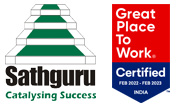Today’s business environment has become more competitive than ever. Being cost competitive or first mover is no longer sufficient for an organization to thrive in today’s uncertain and dynamic business environment. Organizations now need to constantly generateinsights about industry and consumers and rethink their business strategy in order to remain ahead of the competition. They on a regular basis face complex business issues and are required to choose among various strategic options.Strategy development and execution process is a time consuming and costly affair and Chief Strategy Officers often find themselves grappling with the questions on the success of strategy in beating the market.While it is extremely difficult to predict in foresight with certainty the right answer to such a question, following few basic principles can improve the success rate substantially. In our experience, subjecting the strategy to acid test of following three pre-requisites is useful to gaugeits effectiveness in achieving the long term business goal of the organization:
1. Alignedto the organization’s vision
Every strategic move by an organization creates a long lasting impact towards achieving (or not achieving) its vision. Strategy should be assessed for its ability to contribute to the attainment of organization’s vision. For instance,if an organization’svision is to become market leader, strategy focused on increasing market share organically or inorganically will be effective while for organization wanting to be the most trusted brand, focus on quality improvement and image building would make more sense. Strategy formulation process is transforming from CEOs and Board of Directorsdomain to a core corporate function,making it more critical to evaluate the strategy for alignment fit with the organization’s vision.
2. Accounting for competitor response
Today markets are rarely without existing or potential competition. Competitor’s choice of not to act should not be taken as his inability to act. Many strategies which seem competitive in first place fall apart in event of counter response from competitor. For example a price reduction does not always guarantee increase in market share if competitor has ability to match or better the price. Similarly launching a new product would be futile if it can be easily replicated.Winning strategies are based on solid entry barriers such as patent, IP, time value, financial competency etc. rather than information asymmetry. Strategy should be critically evaluated for source of competitive advantage and best way to do this is by stepping in the shoes of existing or potential competitor and assessing how easy or difficult it will be to develop a counter strategy.
3. Free from bias
It is not uncommon for strategicdecision making process to get affected by bias. Strategies are based on hypothesis derived from analysis and interpretation of large amount of information and data. Strong conviction in particular hypothesis can unconsciously result in ignoring information relevant to disprove the hypothesis. Generalization of perceptions can also tilt the interpretation and analysis towards biased conclusions. In certain cases, strategist’s specific background and experience can be a source of bias. Evaluation of strategy and its underlying assumptions and hypothesis by cross functional team or external consultants, which brings broader functional and industry perspective, can help in identifying conviction and perception driven biasesthat leads to failure of strategy in market place.


